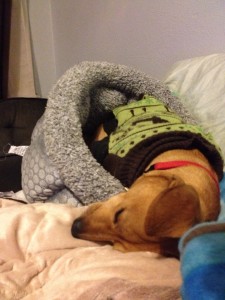All of my dogs wear sweaters or coats in the winter, all but one. The small and or short hair dogs need the warmth and they even wear their sweaters in the house. Right or wrong, I have found that sweatering a long hair dog will keep their natural winter undercoat from going full bore and that in turn saves me a lot of headache when they shed their winter coats in the spring.
But the thought of putting a sweater on our streety Husky, that just seemed ridiculous. Not that Tasha hasn’t learned to love a good raincoat, but a winter coat on a Husky? A former wild dog has to have some dignity, right?
Wrong. A few weeks after the ice storm, the marvelously manic Texas weather brought us 70 degree temperatures. One does not need an arctic coat in 70 temperatures. Nature always knows what to do. Tasha’s body started correcting for the conditions and she starting blowing coat, piles and piles of static electric coat.
Almost as mind boggling and entertaining as the sheer volume of undercoat cotton ball molting that goes on when a Husky sheds, a winter time Husky has the most amazingly static electric coat. Sparks fly off of Tasha’s back when you give her a good rub. It’s a furry electric light show. My black clothes and that dog’s static hair are like magnetic poles – just being near the dog enables the loose hairs to jump off the dog and cling to my clothes like magnets. Her hair is magnetically and dynamically attracted to black. Even the black lab mix, Claire, turns white with Husky hair when Tasha passes by her.
The other day, I was frantically trying to brush dog hair from my black coat before heading into a meeting. With each brush the hair was sticking with increased vigor. I tried brushing slower, faster, in different directions to no avail.
Panic started to set in. I was going to be late to a meeting because I was beating husky hair off my coat in a parking lot. As I was flailing around contorting myself to see where all the new hair was coming from, I realized that not only were my efforts not working, but the hairs were multiplying! I am an adult human being with opposable thumbs – how can Husky hair be winning?
Eventually I resigned myself to going to the meeting looking like a ridiculous unkempt dog mess. As I turned the corner toward the building, the wind started whipping. I looked down to button my coat and miraculously, all the hairs were gone. At that moment I had an epiphany – I just need to use a leaf blower on myself before I leave the house every day. Problem solved.
Later, not fully convinced that the leaf blower was a practical solution (I’m not saying it wouldn’t work – I may try that in a desperate situation at some point in the near future), I turned to the almighty internet for help. There is some good stuff out there on that interweb. I knew a lot of the tips, the yellow rubber gloves work great for most dog hair, and I learned some new tips for my static Husky hair. I’ll let you know how it works when I get a hold of a rubber broom.
Here are some simple, useful tips from WIkihow on how to fight back dog hair in your life. Husky people – I am standing by for some additional guidance here….and in the future, when you see me rubbing a balloon on my body or see a picture of Tasha walking in a sweater – don’t judge.
From Wikihow on how to get a handle on dog hair:
1. Weigh it down. Soak the palm of your hand. Wipe the pet hair off in a downward motion. The hair will ball up and stick to your damp hand. This works because the hair becomes wet, therefore heavier. This results in it being unable to stick to your pants (or whatever surface you’re dealing with) in response to static electricity.
2. Barely dampen a clean, regular kitchen sponge. Use a sponge mop if you’re removing pet hair from a low-pile carpet, in which case the floor should be thoroughly vacuumed first. Rub the fabric, upholstery, or carpet with the sponge. The fur should roll up into clumps that you can pick off by hand
3. Put on a latex glove. Rub the surface with it on. The pet hair should stick to your glove. This also works with rubber gloves or cloth gardening gloves with a rubber coating on the palm. A rubber bristle push broom can work in the same way on floors. Dampen the glove or rubber section of the glove for increased effectiveness
4. Inflate a balloon. Rub it across the surface that has pet hair on it. The static on the balloon’s surface will attract the hair (and works on yours, too!), which you can collect and then re-use the balloon to get more hair.
5. Rub velcro curlers on the surface to catch the hair. If the curler has a metal inner form, it can be bent to reach corners.
6. Apply fabric softener. A fabric softener sheet that normally goes in the dryer can be used to pick up pet hair. You can also mist the surface with a mixture of fabric softener and water to “prep” the area before removing the pet hair using any of the other methods.
7. Consider preventive measures. Place your clothing in an area isolated from your pets orgroom them regularly to reduce the amount of loose hair on them. You should also vacuum carpets and furniture regularly, and wash the throw rugs and linens that the pets have contact with.
8. You can use sellotape to peel off some fur. Just wrap some around your hand with the sticky, adhesive part sticking out and tap it on the fur-covered areas.
9. Use a rubber broom. This is effectively for especially stubborn pet hair that sticks to a surface. The bristles work with static electricity and the hair jumps onto the brush.

Frankie passed out in his sweater – looking surprisingly comfortable falling asleep half out of his bed
So back to the topic of sweaters…here is one last link with information from VetStreet on whether or not to put clothes on your dog and how to make sure they are safe and comfortable when you do. From VetStreet:
Q. How do I know if my dog needs a sweater or coat this winter?
A. If you have a healthy, young Siberian Husky or Alaskan Malamute who’s acclimated to the cold and has the glorious coat common in the Northern breeds, you likely won’t have to invest in canine clothing for walks in the snow. In general, there are three kinds of dogs who benefit from the insulation provided by a sweater or coat, as well as the protection afforded by life as a pampered house pet:
- Small dogs
- Dogs who are elderly, chronically ill or both
- Greyhounds, Whippets and dogs of a similar thin body type, especially those with short fur
What these dogs have in common is that they have a more difficult time generating and retaining enough body heat on their own. For these dogs, a little help keeping dry and warm is always a good thing. Though protection from the elements is the biggest reason to put clothes on dogs headed outside, it doesn’t hurt to leave a sweater on these dogs inside if you’re keeping the heat down to save energy and money.
If you have a dog with arthritis, protective clothing is just one thing you can do to make winters more comfortable. Pet-safe heated orthopedic beds are a great idea; you can also talk to your veterinarian about nutraceuticals, such as glucosamine and omega-3 oils that are clinically proven to ease joint pain. Other dogs may benefit additionally from the use of pain-control medication, typically nonsteroidal anti-inflammatory drugs (NSAIDs).
Even if your dog doesn’t need a coat, having one certainly won’t hurt him. I know many people who put slickers on their pets before taking a walk in the rain or snow because it saves them the trouble of cleaning a wet dog at the door before coming inside, for example. Boots help keep things neater, too, and where de-icing solutions are used, they can protect your pet from licking toxic chemicals off his paws.








